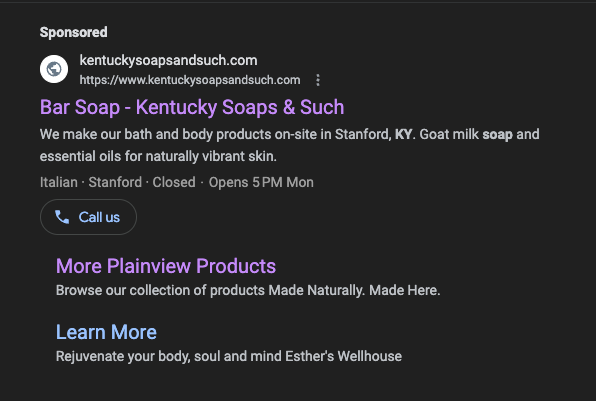KENTUCKY SOAPS & SUCH
FINDING NATURAL PRODUCT FANS

Kentucky Soaps & Such makes high quality, natural body care products on-site at their store in Stanford, Kentucky. The problem was the combination of the relatively small population base in their local market and the lack of awareness outside of it meant very few people got to experience these products for themselves.
Beyond that, the business had made little to no investment in advertising as of 2019. They had a strong local following, along with a strengthened social media presence, and a much-improved website and POS system on the way, but they needed a way to begin reaching buyers outside their natural footprint without breaking the bank.
THE CHALLENGE
Reach potential customers beyond the local store footprint.
A Beautiful, But Small Market
Stanford has a lot going for it, especially since Jess and Angela Correll brought their Wilderness Road Hospitality businesses there, but the local population is still very small compared to other cities. Even by convincing other shoppers in their very rural part of the state to make the drive to the store, there’s still a limit to how many natural body care products you can reasonably expect to sell.
Reaching Like-Minded Customers
Consumers are gradually becoming more conscious of the potentially harmful effects of synthetically produced products, especially those we use in or on our bodies. Kentucky Soaps & Such could connect with millions of customers online who would prefer to use their effective and natural body care products. They just had to find the right way to reach those folks without biting off a large initial investment.
THE SOLUTIONS
Use highly targeted and low-cost digital advertising channels to reach customers online.

Meta
The Meta ad network offers a flexible and highly targeted delivery platform for digital ad content. The large user base on Facebook and Instagram offers advertisers opportunities to advertise via boosted posts, reels, stories, videos, and direct shopping. In the case of Kentucky Soaps & Such we used all of the above in some capacity throughout our engagement together, often in combination with AI sourced targeting models to customize asset delivery based on the viewer. Meta also allowed us to connect the Shopify product catalog to sell products directly on Facebook and Instagram without the need for separate fulfillment.
Google has been at the forefront of digital advertising advancements from the beginning. In addition to tried and true search-based ads, they also offer ads on YouTube, Gmail, business listings, and third-party websites. We were able to run campaigns across all these channels and connect the Shopify product catalog to sell items on Google Shopping without the need for additional logistics. The recent advancements in AI modeling have made it possible to deliver custom combinations of ad content specifically tailored for the viewer and we took advantage of that feature.
YouTube
YouTube offers many combinations of skippable and non-skippable video ads to accompany their most popular content. If used effectively, these ads can be highly targeted and highly effective for building awareness.
Spectrum
We partnered with Spectrum to deliver streaming TV ads to viewers around the state. While attribution numbers are not as easily traceable as other platforms, the nature of streaming TV allows for targeting specifics as just as narrow as other digital-first channels. Since these ads did not drive direct clicks to the website, success had to be measured by changes in POS sales.
Emails
Building a contact list for leads and nurturing them via email and SMS is one of the fundamental pillars of effective digital marketing. In the case of Kentucky Soaps & Such, Shopify offered a direct integration with MailChimp for building tagged contact lists and automated customer journeys.
Beyond collecting contacts for manual sends, we were able to utilize the integration to trigger abandoned cart emails, inactive shopper emails, VIP offers, and more. The combination of behavioral targeting and automated journeys allowed us to send a higher volume of emails to drive customer actions without investing in more staff.

SMS
Text messages are hard to ignore, which means you must be judicious in using them for your business or you risk hurting customer sentiment. The trick is to keep the overall volume low and to make sure the value proposition for reading the texts always favors the customers.
Rather than using text for sharing general advertising, we used it for sharing special offers, sending abandoned cart reminders, and announcements related to product launches. This kept investment numbers low and returns high.

The store’s move to Shopify for online and in-store sales solved practical problems like reducing hardware investments and improving inventory accuracy. It also gave them access to more and better tools for advertising, tracking, and automation than ever before. They now had direct connections to sell on their social media profiles, on Google, in paid digital ads, and via email.
THE RESULTS
Kentucky Soaps and Such saw at least double their return on investment in sales from spending on digital marketing from 2020 through 2023. The average ROI for individual ad campaigns was more than 90%. Most importantly, more than 81% of registered customers are now out-of-state.

SOURCED FROM SHOPIFY

SOURCED FROM GOOGLE

SOURCED FROM WOOCOMMERCE & SHOPIFY

SOURCED FROM META, GOOGLE, SPECTRUM & SHOPIFY

SOURCED FROM SHOPIFY







